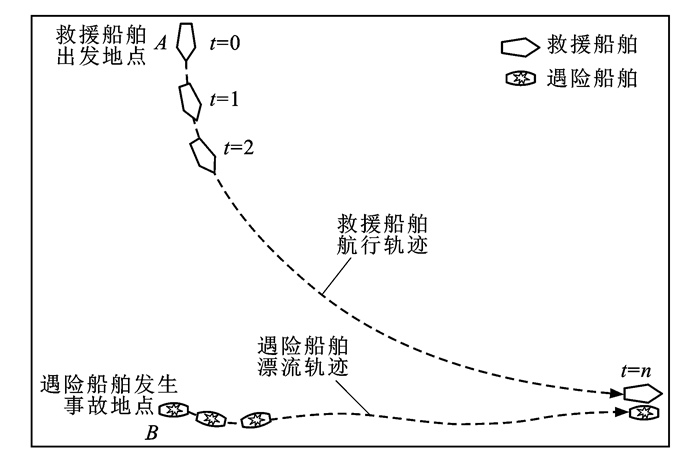Associated searching and rescuing optimization of salvage vessels and helicopters in remote sea area
-
摘要: 以救援船舶行驶路线、释放救援直升机时刻与救援直升机搜索方案为优化内容,以搜救时间最短和发现概率最大为目标,建立了海空联合搜救双目标优化模型,并结合地理信息系统和智能算法设计了模型求解算法; 利用地理信息系统模拟了复杂海洋环境中风、浪因素影响下的救援船舶和遇险船舶运行状态,采用自适应混沌搜索替代随机搜索,改进了传统粒子群算法; 以从南海永兴岛出发前往边远海域执行搜救任务为算例,验证了搜救优化模型。研究结果表明:利用地理信息系统与智能算法结合的海空联合搜救方法得到的搜救行动总时间为4.4~16.9 h,发现概率可达45.12%~99.76%;与传统的粒子群算法相比,改进后的粒子群算法在发现概率分别为85.00%、90.00%与95.00%的情况下,搜救总时间分别减少1.5、1.3与1.1 h,减少幅度分别为18.07%、14.28%与10.57%,改进后的算法在计算速度、计算稳定性与结果优化方面均效果良好; 海空联合搜救方案优化与传统的多目标路径优化问题有所不同,需要建立特定的海空联合搜救模型,结合新的技术手段开展研究; 未来建议发展不同船型、机型参与的海空联合搜救优化方法,以适应不断提高边远海域搜救行动效率的发展要求。Abstract: A bi-objective optimization model of air-sea associated searching and rescuing (SAR) was built, which took the time when the helicopter took off from the salvage vessel and the search plan of helicopter as optimization content, and aimed to minimize the SAR time and maximize the probability of discovery. An improved algorithm was designed based on a the geographic information system (GIS) and intelligent algorithms. The GIS was used to calculate the statuses of salvage vessels and vessels in distress under the influence of wind and wave factors in view of the changeable marine environment. The self-adaptive chaos search was used instead of random search to improve the particle swarm optimization algorithm. An example of the salvage vessel carrying a helicopter from Yongxing Island in the South China Sea to a remote sea area was used to verify the optimization model. Research results show that the total SAR time required for the SAR plan using GIS and intelligence algorithms is 4.4-16.9 h and the discovery probability is 45.12%-99.76%. Compared with the traditional particle swarm algorithm, the total SAR time of the improved particle swarm algorithm reduces by 1.5, 1.3, and 1.1 h, with a decrease rate of 18.07%, 14.28%, and 10.57% when the probability of discovery is 85.00%, 90.00%, and 95.00%, respectively. The improved algorithm shows better effect on calculation speed, calculation stability, and optimization result. The optimization of air-sea associated SAR is different from the traditional multi-objective routing optimization problem, and a new model that combines the improved algorithm is needed. To improve the efficiency of SAR in remote sea areas, it is suggested to further develop the optimization method used for air-sea associated SAR for different types of salvage vessels and helicopters. 6 tabs, 10 figs, 32 refs.
-
表 1 IGD值对比
Table 1. Comparison of IGD values
测试函数 传统粒子群算法 改进粒子群算法 计算结果 计算结果 改进幅度 平均值/10-4 最小值/10-4 标准差/10-4 平均值/10-4 最小值/10-4 标准差/10-4 平均值改进幅度/% 最小值改进幅度/% 标准差改进幅度/% Z1 11.00 8.90 1.40 9.20 7.80 0.75 16.36 12.36 46.43 Z2 8.30 7.20 0.86 7.40 6.80 0.54 10.84 5.56 37.21 Z3 36.00 33.00 2.40 33.00 30.00 1.50 8.33 9.09 37.50 Z4 33.00 23.00 9.60 23.00 17.00 5.10 30.30 26.09 46.88 表 2 SPM值对比
Table 2. Comparison of SPM values
测试函数 传统粒子群算法 改进粒子群算法 计算结果 计算结果 改进幅度 平均值/10-4 最小值/10-4 标准差/10-4 平均值/10-4 最小值/10-4 标准差/10-4 平均值改进幅度/% 最小值改进幅度/% 标准差改进幅度/% Z1 24.00 21.00 2.20 20.00 18.00 1.40 16.67 14.29 36.36 Z2 21.00 17.00 3.10 18.00 13.00 1.80 14.29 23.53 41.94 Z3 61.00 31.00 8.20 41.00 29.00 5.40 32.79 6.45 34.15 Z4 43.00 50.00 24.00 29.00 14.00 17.00 32.56 72.00 29.17 表 3 海上风、浪数据
Table 3. Data of wind and wave in sea
时间/h 实测风向/(°) 实测风速/(m·s-1) 基于GIS预测的救援船舶位置浪高/m 基于GIS预测的漂移船舶位置浪高/m 0.0 33.1 22.4 4.1 4.2 0.5 41.2 21.2 5.1 4.5 1.0 61.4 21.3 4.5 3.9 1.5 34.1 22.3 3.7 4.3 2.0 40.6 21.5 4.9 5.1 2.5 40.0 21.8 5.0 4.8 3.0 47.2 21.5 4.0 3.7 3.5 45.5 21.1 4.2 4.7 4.0 46.6 21.9 4.8 4.1 4.5 53.6 22.5 3.6 3.6 5.0 58.8 21.9 5.2 4.1 5.5 53.7 21.1 4.8 4.6 6.0 57.6 22.6 4.5 5.0 6.5 40.0 21.7 3.8 3.9 7.0 33.8 22.1 4.6 4.8 7.5 49.4 22.6 4.8 3.6 8.0 52.6 21.9 4.9 4.2 8.5 46.3 21.6 4.8 3.8 9.0 41.0 22.6 4.9 5.0 9.5 61.1 21.8 5.3 4.4 10.0 38.9 21.6 3.8 5.0 10.5 39.5 21.9 5.1 4.2 11.0 38.9 21.9 5.3 5.0 11.5 35.7 21.4 4.6 3.8 表 4 救援船舶和遇险船舶数据
Table 4. Data of salvage vessels and vessels in distress
时间/h 风、浪影响下的救援船舶航速/kn 遇险船舶航速/kn 遇险船舶航向/(°) 遇险船舶位置/n mile 救援船舶位置/n mile 0.0 19.967 4.342 33.1 (200.00, 0.00) (0.00, 0.00) 0.5 19.969 4.647 41.2 (201.85, 1.49) (9.99, 0.07) 1.0 19.968 4.522 61.4 (202.94, 2.62) (19.99, 0.21) 1.5 19.966 4.446 34.1 (204.10, 4.54) (29.99, 0.44) 2.0 19.969 3.414 40.6 (205.23, 5.71) (39.99, 0.74) 2.5 19.969 5.023 40.0 (206.66, 7.03) (49.98, 1.12) 3.0 19.967 4.940 47.2 (208.45, 8.38) (59.97, 1.58) 3.5 19.967 4.672 45.5 (209.62, 9.61) (69.96, 2.11) 4.0 19.969 4.369 46.6 (210.94, 11.48) (79.94, 2.78) 4.5 19.966 4.355 53.6 (212.18, 12.52) (89.91, 3.51) 5.0 19.970 4.465 58.8 (213.91, 14.26) (99.87, 4.37) 5.5 19.969 4.436 53.7 (215.82, 15.78) (109.83, 5.35) 6.0 19.968 3.897 57.6 (217.63, 17.40) (119.76, 6.46) 6.5 19.966 3.352 40.0 (218.99, 18.62) (129.68, 7.69) 7.0 19.968 4.722 33.8 (220.34, 20.52) (139.59, 9.08) 7.5 19.969 3.528 49.4 (221.91, 22.17) (149.47, 10.65) 8.0 19.969 3.541 52.6 (223.84, 23.76) (159.31, 12.39) 8.5 19.969 3.773 46.3 (225.08, 25.49) (169.12, 14.34) 9.0 19.969 3.870 41.0 (226.54, 27.39) (178.87, 16.56) 9.5 19.970 4.371 61.1 (227.83, 28.94) (188.57, 19.01) 10.0 19.966 5.112 38.9 (229.82, 30.80) (198.18, 21.76) 10.5 19.969 4.663 39.5 (230.85, 31.99) (207.73, 24.75) 11.0 19.970 5.028 38.9 (232.54, 33.09) (217.20, 27.94) 11.5 19.968 3.630 35.7 (234.30, 34.80) (226.48, 31.66) 12.0 (236.20, 36.78) (235.33, 36.32) 表 5 改进算法运算结果
Table 5. Improved algorithm's computational result
约束概率/% 起飞时刻/h 起飞时与遇险船舶之间的距离/n mile 飞机搜索航线间隔/n mile 搜寻时间/h 发现概率/% 85.00 3.0 145.40 1.60 6.8 85.50 90.00 4.0 128.50 1.30 7.8 90.30 95.00 5.5 102.60 0.96 9.3 95.50 表 6 算法对比
Table 6. Comparison of algorithms
约束概率/% 传统粒子群算法 改进粒子群算法 发现概率/% 搜寻时间/h 发现概率/% 搜寻时间/h 搜寻时间缩减幅度/% 85.00 85.10 8.3 85.50 6.8 18.07 90.00 90.20 9.1 90.30 7.8 14.28 95.00 95.10 10.4 95.50 9.3 10.57 -
[1] 艾兵, 杨睿. 直升机海上搜索航路辅助规划算法[J]. 电光与控制, 2017, 24(11): 91-94, 99. https://www.cnki.com.cn/Article/CJFDTOTAL-DGKQ201711021.htmAI Bing, YANG Rui. An algorithm of auxiliary route planning for helicopter marine search[J]. Electronics Optics and Control, 2017, 24(11): 91-94, 99. (in Chinese) https://www.cnki.com.cn/Article/CJFDTOTAL-DGKQ201711021.htm [2] 严建钢, 杨士锋. 直升机应召搜潜中一种快速搜索方式研究[J]. 运筹与管理, 2016, 5(4): 44-48. https://www.cnki.com.cn/Article/CJFDTOTAL-YCGL201604008.htmYAN Jian-gang, YANG Shi-feng. A quick search method for summoned antisubmarine based on helicopter[J]. Operations Research and Management Science, 2016, 25(4): 44-48. (in Chinese) https://www.cnki.com.cn/Article/CJFDTOTAL-YCGL201604008.htm [3] 张福光. 直升机海上搜救最优模式研究[J]. 系统工程理论与实践, 2001(3): 87-91. doi: 10.3321/j.issn:1000-6788.2001.03.017ZHANG Fu-guang. Study of the optimal search and rescue model of helicopter on sea[J]. Systems Engineering-Theory and Practice, 2001(3): 87-91. (in Chinese) doi: 10.3321/j.issn:1000-6788.2001.03.017 [4] 盖文妹, 蒋仲安, 邓云峰, 等. 应急救援物资车辆运输路线多目标优化[J]. 北京科技大学学报, 2014, 36(10): 1384-1393. https://www.cnki.com.cn/Article/CJFDTOTAL-BJKD201410016.htmGAI Wen-mei, JIANG Zhong-an, DENG Yun-feng, et al. Multi-objective route optimization of transporting emergency goods and materials for rescue[J]. Journal of University of Science and Technology Beijing, 2014, 36(10): 1384-1393. (in Chinese) https://www.cnki.com.cn/Article/CJFDTOTAL-BJKD201410016.htm [5] 张雷, 马璐, 元昌安. 应急救援多目标时限指派模型[J]. 中国安全科学学报, 2012, 22(6): 170-176. doi: 10.3969/j.issn.1003-3033.2012.06.027ZHANG Lei, MA Lu, YUAN Chang-an. Research on multi-objective model for emergency rescue assignment with time limit[J]. China Safety Science Journal, 2012, 22(6): 170-176. (in Chinese) doi: 10.3969/j.issn.1003-3033.2012.06.027 [6] 王海军, 杜丽敬, 胡蝶, 等. 不确定条件下的应急物资配送选址-路径问题[J]. 系统管理学报, 2015, 24(6): 828-834. https://www.cnki.com.cn/Article/CJFDTOTAL-XTGL201506006.htmWANG Hai-jun, DU Li-jing, HU Die, et al. Location-routing problem for relief distribution in emergency logistics under uncertainties[J]. Journal of Systems and Management, 2015, 24(6): 828-834. (in Chinese) https://www.cnki.com.cn/Article/CJFDTOTAL-XTGL201506006.htm [7] AKBARI A, PELOT R, EISELT H A. A modular capacitated multi-objective model for locating maritime search and rescue vessels[J]. Annals of Operations Research, 2018, 267: 3-28. doi: 10.1007/s10479-017-2593-1 [8] 孙世彬, 田勇. 船机立体配合技术在海难救助中的应用[J]. 航海技术, 2011(5): 28-30. https://www.cnki.com.cn/Article/CJFDTOTAL-HHJS201105012.htmSUN Shi-bin, TIAN Yong. Application of ship machine three-dimensional cooperation technology in shipwreck rescue[J]. Marine Navigation, 2011(5): 28-30. (in Chinese) https://www.cnki.com.cn/Article/CJFDTOTAL-HHJS201105012.htm [9] 谢立成, 周元波. 救助直升机船载工作的探讨[J]. 世界海运, 2016, 39(12): 39-44. https://www.cnki.com.cn/Article/CJFDTOTAL-HYZZ201612010.htmXIE Li-cheng, ZHOU Yuan-bo. Discussion on the shipborne work of rescue helicopter[J]. World Shipping, 2016, 39(12): 39-44. (in Chinese) https://www.cnki.com.cn/Article/CJFDTOTAL-HYZZ201612010.htm [10] 杜永浩, 邢立宁, 陈盈果. 多平台海上协同搜索与路径优化策略研究[J]. 控制与决策, 2020, 35(1): 147-153. https://www.cnki.com.cn/Article/CJFDTOTAL-KZYC202001019.htmDU Yong-hao, XING Li-ning, CHEN Ying-guo. Strategies of maritime cooperative searching and path optimizing using multiple platforms[J]. Control and Decision, 2020, 35(1): 147-153. (in Chinese) https://www.cnki.com.cn/Article/CJFDTOTAL-KZYC202001019.htm [11] 王书晓, 李伟, 郑亚波, 等. 舰机协同海上搜寻关键问题研究[J]. 指挥控制与仿真, 2016, 38(1): 34-37. doi: 10.3969/j.issn.1673-3819.2016.01.008WANG Shu-xiao, LI Wei, ZHENG Ya-bo, et al. Several key problems of maritime search of warship-helicopter cooperation[J]. Command Control and Simulation, 2016, 38(1): 34-37. (in Chinese) doi: 10.3969/j.issn.1673-3819.2016.01.008 [12] 焦俊超, 马安青, 娄安刚, 等. GIS和Google Earth开发在溢油预测中的整合应用[J]. 遥感技术与应用, 2011, 26(2): 215-219. https://www.cnki.com.cn/Article/CJFDTOTAL-YGJS201102013.htmJIAO Jun-chao, MA An-qing, LOU An-gang, et al. The integration application of GIS and Google Earth development in oil spill prediction[J]. Remote Sensing Technology and Application, 2011, 26(2): 215-219. (in Chinese) https://www.cnki.com.cn/Article/CJFDTOTAL-YGJS201102013.htm [13] 焦俊超, 马安青, 娄安刚, 等. 基于GIS的渤海湾溢油预测系统研究[J]. 海洋环境科学, 2011, 30(5): 735-738. doi: 10.3969/j.issn.1007-6336.2011.05.030JIAO Jun-chao, MA An-qing, LOU An-gang, et al. Prediction of oil spill based on GIS in Bohai Bay[J]. Marine Environmental Science, 2011, 30(5): 735-738. (in Chinese) doi: 10.3969/j.issn.1007-6336.2011.05.030 [14] 苏京志, 王东晓, 陈举, 等. 利用回归模型模拟卫星跟踪海洋漂流浮标轨迹[J]. 地球科学进展, 2005, 20(6): 607-617. doi: 10.3321/j.issn:1001-8166.2005.06.003SU Jing-zhi, WANG Dong-xiao, CHEN Ju, et al. Modeling the trajectories of satellite-tracked drifters with regression models[J]. Advances in Earth Science, 2005, 20(6): 607-617. (in Chinese) doi: 10.3321/j.issn:1001-8166.2005.06.003 [15] 魏延亮, 张建辉. 基于GIS的海洋渔业应急救援系统建设研究[J]. 测绘与空间地理信息, 2013, 36(2): 56-58. doi: 10.3969/j.issn.1672-5867.2013.02.016WEI Yan-liang, ZHANG Jian-hui. Research of construction of ocean finish emergency rescue system based on the GIS[J]. Geomatics and Spatial Information Technology, 2013, 36(2): 56-58. (in Chinese) doi: 10.3969/j.issn.1672-5867.2013.02.016 [16] 黎夏, 叶嘉安. 遗传算法和GIS结合进行空间优化决策[J]. 地理学报, 2004, 59(5): 745-753. doi: 10.3321/j.issn:0375-5444.2004.05.013LI Xia, YE Jia-an. Optimal spatial search using genetic algorithms and GIS[J]. Acta Geographica Sinica, 2004, 59(5): 745-753. (in Chinese) doi: 10.3321/j.issn:0375-5444.2004.05.013 [17] 肖方兵, 尹勇, 金一丞, 等. 基于随机粒子仿真的海上搜寻区域确定[J]. 中国航海, 2011, 34(3): 34-39. doi: 10.3969/j.issn.1000-4653.2011.03.008XIAO Fang-bing, YIN Yong, JIN Yi-cheng, et al. Determination of maritime search area based on stochastic particle simulation[J]. Navigation of China, 2011, 34(3): 34-39. (in Chinese) doi: 10.3969/j.issn.1000-4653.2011.03.008 [18] ROHWEDER J J, ROGALA J T, JOHNSON B L, et al. Application of wind fetch and wave models for habitat rehabilitation and enhancement projects[R]. Reston: United States Geological Survey, 2012. [19] 何惠明, 董国祥, 蒋永旭. 运输船舶在波浪中失速的近似估算[J]. 上海船舶运输科学研究所学报, 2009, 32(2): 6-9. doi: 10.3969/j.issn.1674-5949.2009.02.002HE Hui-ming, DONG Guo-xiang, JIANG Yong-xu. Approximate estimation for ship speed loss in waves[J]. Journal of SSSRI, 2009, 32(2): 6-9. (in Chinese) doi: 10.3969/j.issn.1674-5949.2009.02.002 [20] 何惠明, 董国祥, 蒋永旭. 85 000 t油轮在波浪中的阻力增加和失速预报[J]. 中国航海, 2011, 34(4): 67-70, 80. doi: 10.3969/j.issn.1000-4653.2011.04.015HE Hui-ming, DONG Guo-xiang, JIANG Yong-xu. The study on prediction of added the resistance and speed loss in the wave with 85 000 DWT tank[J]. Navigation of China, 2011, 34(4): 67-70, 80. (in Chinese) doi: 10.3969/j.issn.1000-4653.2011.04.015 [21] 张进峰, 石志超, 项勇. 寒潮大风浪中船舶失速数值计算[J]. 大连海事大学学报, 2014, 40(2): 39-42. doi: 10.3969/j.issn.1006-7736.2014.02.010ZHANG Jin-feng, SHI Zhi-chao, XIANG Yong. Numerical calculation of ship speed loss in rough seas with cold wave[J]. Journal of Dalian Maritime University, 2014, 40(2): 39-42. (in Chinese) doi: 10.3969/j.issn.1006-7736.2014.02.010 [22] 李金铎, 龙绍桥, 郑锡建. 东海海域渔船无动力漂移试验研究[J]. 渔业现代化, 2011, 38(1): 60-63. doi: 10.3969/j.issn.1007-9580.2011.01.014LI Jin-duo, LONG Shao-qiao, ZHENG Xi-jian. Experimental study of fishing boat off-power float in the East China Sea[J]. Fishery Modernization, 2011, 38(1): 60-63. (in Chinese) doi: 10.3969/j.issn.1007-9580.2011.01.014 [23] 马文耀, 陈达森, 毕修颖. 基于流场数值模拟的遇险目标漂移计算研究[J]. 中国航海技术, 2009, 32(2): 45-48. https://www.cnki.com.cn/Article/CJFDTOTAL-ZGHH200902014.htmMA Wen-yao, CHEN Da-sen, BI Xiu-ying. Study of distress target drift based on numerical simulation of flow field[J]. Navigation of China, 2009, 32(2): 45-48. (in Chinese) https://www.cnki.com.cn/Article/CJFDTOTAL-ZGHH200902014.htm [24] 翁怡婵, 杨金湘, 江毓武. 台湾海峡漂移物运动轨迹的数值模拟[J]. 厦门大学学报: 自然科学版, 2009, 48(3): 446-449. doi: 10.3321/j.issn:0438-0479.2009.03.030WENG Yi-chan, YANG Jin-xiang, JIANG Yu-wu. Simulation of floater trajectory in Taiwan Strait[J]. Journal of Xiamen University (Natural Science), 2009, 48(3): 446-449. (in Chinese) doi: 10.3321/j.issn:0438-0479.2009.03.030 [25] 李维利. 海上搜救计划的制定[J]. 天津航海, 2013, 127(1): 8-11. doi: 10.3969/j.issn.1005-9660.2013.01.004LI Wei-li. Development of a maritime search and rescue plan[J]. Tianjin Hanghai, 2013, 127(1): 8-11. (in Chinese) doi: 10.3969/j.issn.1005-9660.2013.01.004 [26] 吴翔, 周江华. 海上搜救中发现概率的研究[J]. 中国安全生产科学技术, 2015, 11(1): 28-33. https://www.cnki.com.cn/Article/CJFDTOTAL-LDBK201501005.htmWU Xiang, ZHOU Jiang-hua. Study on probability of detection in marine search and rescue[J]. Journal of Safety Science and Technology, 2015, 11(1): 28-33. (in Chinese) https://www.cnki.com.cn/Article/CJFDTOTAL-LDBK201501005.htm [27] KENNEDY J, EBERHART R. Particle swarm optimization[C]//IEEE. Proceedings of ICNN95-International Conference on Neural Networks. New York: IEEE, 1995: 1942-1948. [28] 黄友能, 宫少丰, 曹源, 等. 基于粒子群算法的城轨列车节能驾驶优化模型[J]. 交通运输工程学报, 2016, 16(2): 118-124, 142. doi: 10.3969/j.issn.1671-1637.2016.02.014HUANG You-neng, GONG Shao-feng, CAO Yuan, et al. Optimization model of energy-efficient driving for train in urban rial transit based on particle swarm algorithm[J]. Journal of Traffic and Transportation Engineering, 2016, 16(2): 118-124, 142. (in Chinese) doi: 10.3969/j.issn.1671-1637.2016.02.014 [29] WANG Gai-ge, GUO Li-hong, GANDOMI A H, et al. Chaotic krill herd algorithm[J]. Information Sciences, 2014, 274: 17-34. doi: 10.1016/j.ins.2014.02.123 [30] ZITZLER E, DEB K, THIELE L. Comparison of multiobjective evolutionary algorithms: empirical results[J]. Evolutionary computation, 2000, 8(2): 173-195. doi: 10.1162/106365600568202 [31] MONTGOMERY W D. Markets in licenses and efficient pollution control programs[J]. Journal of Economic Theory, 1972, 5(3): 395-418. doi: 10.1016/0022-0531(72)90049-X [32] SCHOOT J R. Fault tolerant design using single and multicriteria genetic algorithm optimization[D]. Cambridge: University of Cambridge, 1995. -





 下载:
下载:











